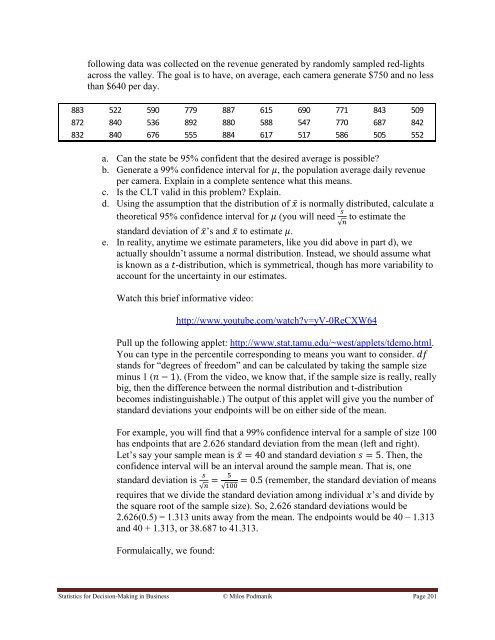Statistics for Decision- Making in Business - Maricopa Community ...
Statistics for Decision- Making in Business - Maricopa Community ...
Statistics for Decision- Making in Business - Maricopa Community ...
You also want an ePaper? Increase the reach of your titles
YUMPU automatically turns print PDFs into web optimized ePapers that Google loves.
follow<strong>in</strong>g data was collected on the revenue generated by randomly sampled red-lights<br />
across the valley. The goal is to have, on average, each camera generate $750 and no less<br />
than $640 per day.<br />
883 522 590 779 887 615 690 771 843 509<br />
872 840 536 892 880 588 547 770 687 842<br />
832 840 676 555 884 617 517 586 505 552<br />
a. Can the state be 95% confident that the desired average is possible<br />
b. Generate a 99% confidence <strong>in</strong>terval <strong>for</strong> , the population average daily revenue<br />
per camera. Expla<strong>in</strong> <strong>in</strong> a complete sentence what this means.<br />
c. Is the CLT valid <strong>in</strong> this problem Expla<strong>in</strong>.<br />
d. Us<strong>in</strong>g the assumption that the distribution of ̅ is normally distributed, calculate a<br />
theoretical 95% confidence <strong>in</strong>terval <strong>for</strong> (you will need to estimate the<br />
√<br />
standard deviation of ̅‟s and ̅ to estimate .<br />
e. In reality, anytime we estimate parameters, like you did above <strong>in</strong> part d), we<br />
actually shouldn‟t assume a normal distribution. Instead, we should assume what<br />
is known as a -distribution, which is symmetrical, though has more variability to<br />
account <strong>for</strong> the uncerta<strong>in</strong>ty <strong>in</strong> our estimates.<br />
Watch this brief <strong>in</strong><strong>for</strong>mative video:<br />
http://www.youtube.com/watchv=yV-0ReCXW64<br />
Pull up the follow<strong>in</strong>g applet: http://www.stat.tamu.edu/~west/applets/tdemo.html.<br />
You can type <strong>in</strong> the percentile correspond<strong>in</strong>g to means you want to consider.<br />
stands <strong>for</strong> “degrees of freedom” and can be calculated by tak<strong>in</strong>g the sample size<br />
m<strong>in</strong>us 1 ( ). (From the video, we know that, if the sample size is really, really<br />
big, then the difference between the normal distribution and t-distribution<br />
becomes <strong>in</strong>dist<strong>in</strong>guishable.) The output of this applet will give you the number of<br />
standard deviations your endpo<strong>in</strong>ts will be on either side of the mean.<br />
For example, you will f<strong>in</strong>d that a 99% confidence <strong>in</strong>terval <strong>for</strong> a sample of size 100<br />
has endpo<strong>in</strong>ts that are 2.626 standard deviation from the mean (left and right).<br />
Let‟s say your sample mean is ̅ and standard deviation . Then, the<br />
confidence <strong>in</strong>terval will be an <strong>in</strong>terval around the sample mean. That is, one<br />
standard deviation is √ √<br />
(remember, the standard deviation of means<br />
requires that we divide the standard deviation among <strong>in</strong>dividual ‟s and divide by<br />
the square root of the sample size). So, 2.626 standard deviations would be<br />
2.626(0.5) = 1.313 units away from the mean. The endpo<strong>in</strong>ts would be 40 – 1.313<br />
and 40 + 1.313, or 38.687 to 41.313.<br />
Formulaically, we found:<br />
<strong>Statistics</strong> <strong>for</strong> <strong>Decision</strong>-<strong>Mak<strong>in</strong>g</strong> <strong>in</strong> Bus<strong>in</strong>ess © Milos Podmanik Page 201
















